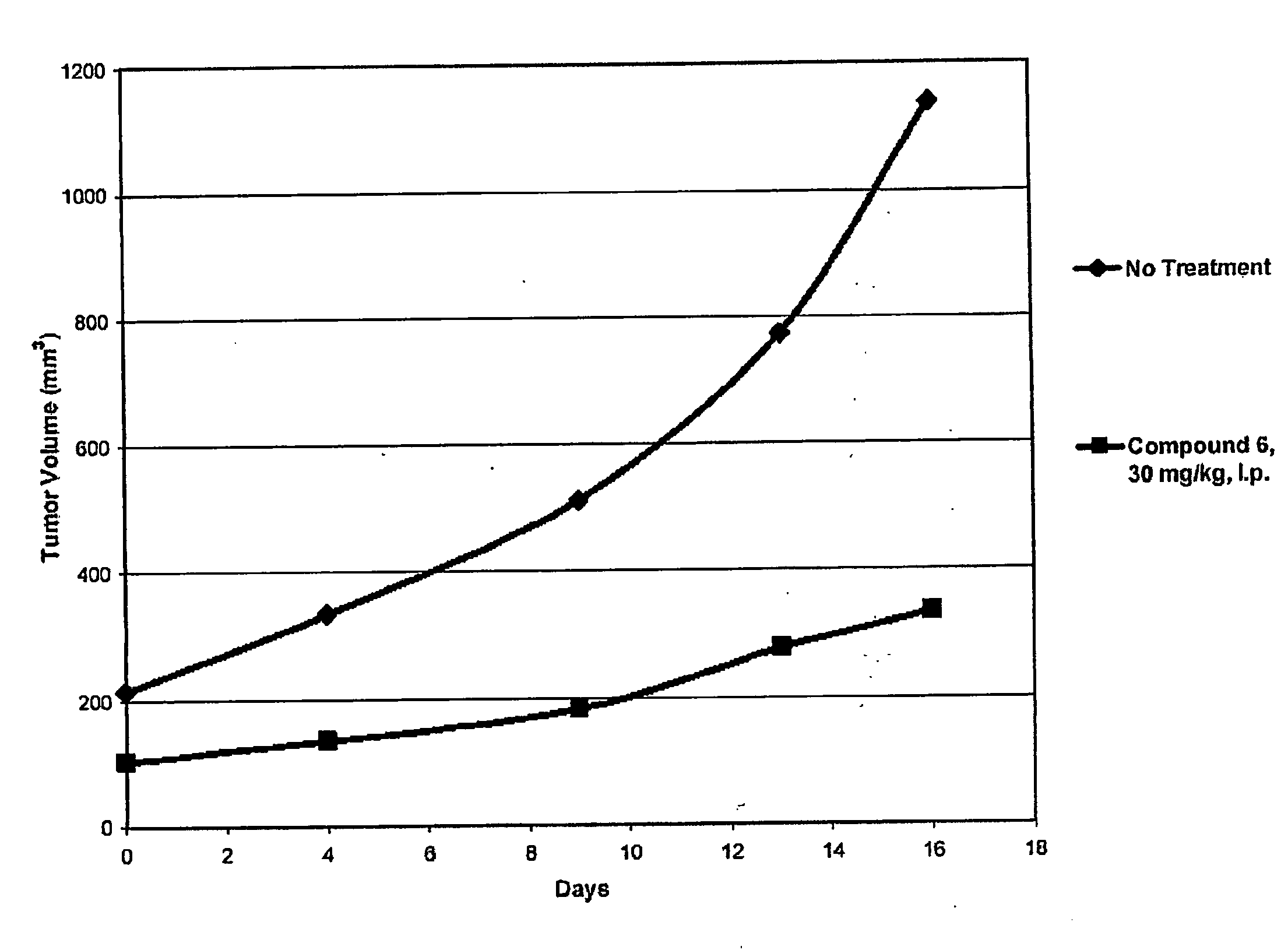Inhibitors of Histone Deacetylase
a technology of histone deacetylase and inhibitors, which is applied in the direction of chemical treatment enzyme inactivation, drug compositions, cardiovascular disorders, etc., can solve the problem that the role of the other individual hdac enzymes remains unclear
- Summary
- Abstract
- Description
- Claims
- Application Information
AI Technical Summary
Benefits of technology
Problems solved by technology
Method used
Image
Examples
example 4
[1063]
N-[2-amino-5-(2-thienyl)phenyl]-I-(3,4,5-trimethoxybenzyl)indoline-6-carboxamide (23)
[1064]
Step 1: Methyl 2,3-Dihydro-IH-indole-5-carboxylate (20)
[1065]To a cold solution of methyl indole-5-carboxylate (2 g, 11.4 mmol) in glacial acetic acid at O° C. (15 ml) sodium cyanoborohydride (1.075 g, 17.1 mmol) was slowly added. The mixture was allowed to warm-up and stirred at room temperature for one more hour, cooled again to O° C. and quenched with H2O. The pH of the resultant solution was adjusted to the value of 12 by adding aqueous NaOH, extracted with DCM, washed with brine and dried over MgSO4. The dried extract was concentrated in vacuum and purified by flash chromatography (eluent 30% EtOAc in hexane) to give the title compound 20 (1.62 g, 80%) as a beige solid. 1H-NMR (DMSO) δ: 2.94 (t, J=8.6 Hz, 2H); 3.51 (dt, J=1.2, 8.6 Hz, 2H); 3.71 (s, 3H); 6.42 (d, J=8.0 Hz, 2H); 7.54 (m, 2H).
Step 2: Methyl I-(3,4,5-Trimethoxy-benzyl)-2,3-dihydro-IH-indole-5-carboxylate (21)
[1066]To a ...
example 5
[1069]
N-[2-amino-5-(2-thienyl)phenyl]-5-{[(3,4,5-trimethoxyphenyl)amino]methyl}-I-benzofuran-2-carboxamide (29)
[1070]
Step 1: Ethyl 5-Methyl-benzofuran-2-carboxylate (25)
[1071]To a stirred suspension of 2-hydroxy-5-methylbenzaldehyde (5 g, 36.7 mmol) and K2CO3 (12.7 g, 91.8 mmol) in DMF (30 ml_), ethyl bromoacetate (4.07 ml, 36.7 mmol) was added drop-wise. This mixture was allowed to stir for two hours under nitrogen at room temperature, and was then heated to 8O° C. and stirred overnight. The reaction was quenched with H2O to form a precipitate which was collected by filtration and purified by flash chromatography (eluent 5% EtOAc in hexane) to give the title compound 25 (2.30 g, 31%). 1H-NMR (CDCl3) δ: 1.45 (t, J=7.0 Hz, 3H); 2.47 (s, 3H); 4.45 (q, J=7.0 Hz, 2H); 7.26 (m, IH); 7.46 (m, 3H).
Steps 2-3. 5-Hydroxymethyl-benzofuran-̂-carboxylic acid ethyl ester (26)
[1072]A mixture of the ester 25 (2.26 g, 11.1 mmol), JV-bromosuccinimide (2.37 g, 13.3 mmol) and VAZO (271 mg, 1.11 mmol) w...
example 6
[1076]
4-{[(3,4-dimethoxyphenyl)amino]methyl}-N-[3-(2-thienyl)phenyl]benzamide (32)
[1077]
Step 1: 3-Thiophen-2-yl-phenylamine (31)
[1078]Following the same procedure as described in Example 1 step 2, but substituting compound 2 for compound 30, the title compound 31 was obtained in 50% yield. 1H NMR: (DMSO) δ (ppm): 7.45 (dd, J=5.1, 1.2 Hz, IH), 7.32 (dd, J=3.7, 1.2 Hz, IH), 7.07 (dd, J=3.7, 1.2 Hz, IH), 7.02 (dd, J=7.7, 7.7 Hz, IH), 6.81 (dd, J=1.9, 1.9 Hz, IH), 6.78 (ddd, J=7.4, 1.6, 0.8 Hz, IH), 6.48 (ddd, J=8.0, 2.3, 1.0 Hz, IH), 5.20 (s, 2H). MS: (calc.) 176.4; (obt.) 175.1 (MH)+.
Step 2: 4-[(3,4-Dimethoxy-phenylamino)-methyl]-N-(3-thiophen-2-yl-phenyl)-benzamide (32)
[1079]To a stirred solution of 31 (122 mg, 0.696 mmol), acid 4 (182 mg, 0.633 mmol) and BOP (308 mg, 0.696 mmol) in DMF (4 ml) was added B3N (265 μl, 1.90 mmol). The reaction was stirred 3 h at room temperature under nitrogen, quenched with H2O and evaporated. The residue was extracted with ethyl acetate, washed with s...
PUM
| Property | Measurement | Unit |
|---|---|---|
| covalent | aaaaa | aaaaa |
| pharmaceutical composition | aaaaa | aaaaa |
Abstract
Description
Claims
Application Information
 Login to View More
Login to View More - R&D
- Intellectual Property
- Life Sciences
- Materials
- Tech Scout
- Unparalleled Data Quality
- Higher Quality Content
- 60% Fewer Hallucinations
Browse by: Latest US Patents, China's latest patents, Technical Efficacy Thesaurus, Application Domain, Technology Topic, Popular Technical Reports.
© 2025 PatSnap. All rights reserved.Legal|Privacy policy|Modern Slavery Act Transparency Statement|Sitemap|About US| Contact US: help@patsnap.com



